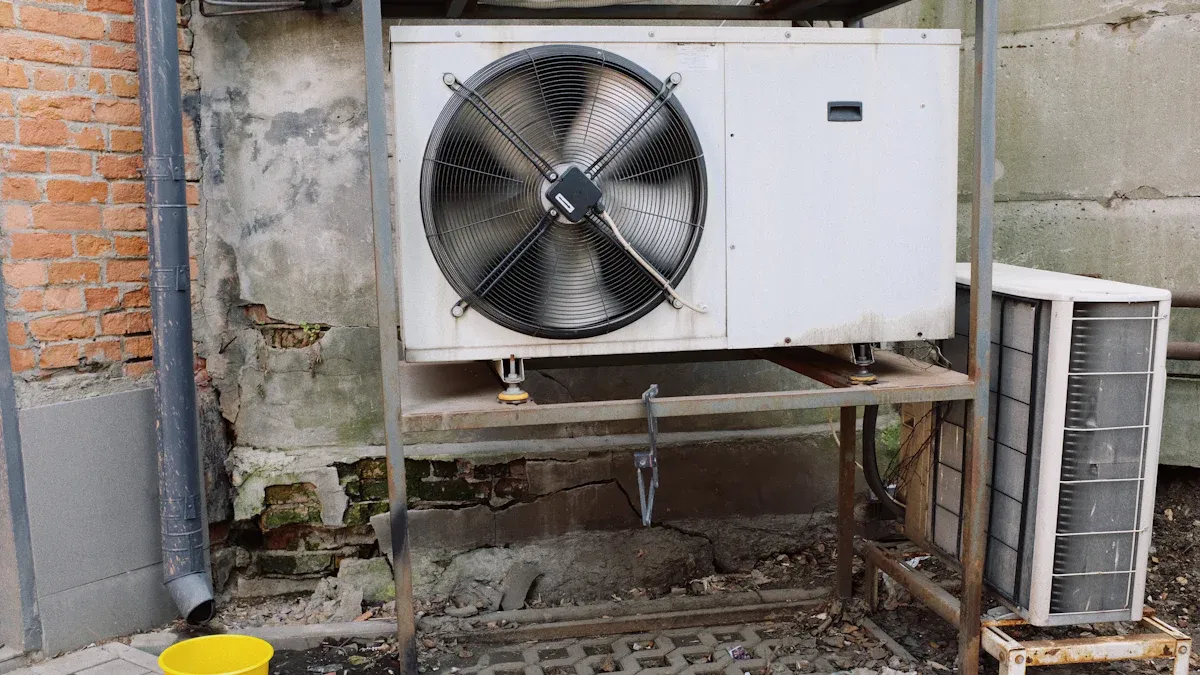Author:
-
Position:
General Manager of Foreign Trade Department, Taojun Refrigeration -
Professional Experience:
Engaged in international trade within the refrigeration industry since 2004.
Expert in brand strategy and omni-channel marketing, having led three multi-million yuan projects that boosted brand exposure by over 200%.
-
Core Competencies:
Proficient in data analysis and user growth strategies.
Skilled in SEO/SEM and social media management tools.
Experienced in cross-departmental collaboration and team leadership.
-
Philosophy:
"Data-driven decisions, creativity-powered branding." Committed to achieving business value and user experience excellence through refined operations. -
Vision:
Eager to collaborate with partners to explore emerging market opportunities and set industry benchmark cases.
Contact Us to Find More Products
Optimizing Medical Refrigeration Systems with Finned Tube Condensers

Medical refrigeration systems play a crucial role in preserving sensitive materials like vaccines, blood samples, and medications. These systems demand precision, reliability, and efficiency to ensure optimal performance. Optimizing medical refrigeration systems with finned tube condensers transforms these systems by improving heat transfer efficiency and enhancing overall functionality. Their advanced design addresses critical challenges in medical refrigeration.
Key Takeaways
- Finned tube condensers help move heat better, keeping temperatures steady for delicate medical items like vaccines and medicines.
- Taking care of refrigeration systems by checking and cleaning them often stops breakdowns and makes them last longer.
- Adding finned tube condensers to current systems makes them work better and use less energy, helping healthcare improve.
The Importance of Medical Refrigeration Systems

Ensuring Precision in Temperature Control
Medical refrigeration systems must maintain precise temperature ranges to preserve the integrity of sensitive materials. Even minor fluctuations can compromise the quality of vaccines, medications, and biological samples. Advanced refrigeration systems equipped with real-time monitoring and alert notifications ensure consistent temperature control. These systems also utilize wireless technology for remote data access, reducing manual errors and improving operational efficiency.
| Evidence Description | Implication |
|---|---|
| Medical refrigerator temperature monitoring systems are crucial for maintaining the storage conditions of sensitive medical products. | Ensures the integrity and effectiveness of medications, impacting patient safety. |
| A slight fluctuation in temperature can compromise the quality of stored medication. | Highlights the importance of precise temperature control in healthcare settings. |
| Real-time monitoring and alert notifications are provided by advanced systems. | Enhances operational efficiency and safety in healthcare facilities. |
Addressing Challenges in Reliability and Efficiency
Reliability and efficiency remain critical challenges in medical refrigeration. Studies reveal that over 30% of cold chain failures result from inconsistent temperature monitoring and lack of backup systems. Additionally, outdated equipment and insufficient training contribute to inefficiencies. High-precision refrigeration systems, such as those utilizing finned tube condensers, address these issues by enhancing heat transfer and reducing energy consumption. These systems also improve fault detection, achieving up to 92% accuracy, which minimizes downtime and ensures uninterrupted operation.
- Continuity of the cold chain is crucial for vaccine potency.
- Disruption of the cold chain leads to avoidable vaccine wastage.
- Over 30% of cold chain failures are attributed to inconsistent temperature monitoring and lack of backup systems.
- Approximately 28% of medical refrigerators in low-income regions lack calibrated sensors, raising compliance issues.
Impacts of System Failures on Healthcare Outcomes
Failures in medical refrigeration systems can have severe consequences for healthcare outcomes. Spoiled vaccines and medications not only result in financial losses but also jeopardize patient safety. Reports indicate that more than 25% of vaccine storage facilities experience at least one incident of product spoilage annually due to equipment failure or human error. By optimizing medical refrigeration systems with finned tube condensers, healthcare facilities can mitigate these risks. These condensers enhance system reliability, ensuring the safe storage of critical medical supplies and improving patient care.
How Finned Tube Condensers Optimize Medical Refrigeration Systems

Design Features of Finned Tube Condensers
Finned tube condensers are engineered to maximize heat exchange efficiency. Their design incorporates extended surfaces, or fins, which increase the surface area available for heat transfer. These fins are strategically spaced to optimize airflow and thermal conductivity. The compact design of these condensers makes them ideal for medical refrigeration systems, where space constraints are common.
The spacing of the fins plays a critical role in performance. For instance, studies show that reducing fin spacing from 4 mm to 2 mm improves performance by 28.8% and reduces energy consumption by 16.4%. Similarly, a 2 mm fin spacing outperforms a 6 mm spacing by 39.5% in performance and 18.7% in energy efficiency.
| Fin Spacing (mm) | Performance Improvement (%) | Energy Reduction (%) |
|---|---|---|
| 2 | 28.8% (compared to 4 mm) | 16.4% (compared to 4 mm) |
| 2 | 39.5% (compared to 6 mm) | 18.7% (compared to 6 mm) |
These design features ensure that finned tube condensers meet the stringent requirements of medical refrigeration systems, providing both reliability and efficiency.
Enhancing Heat Transfer Efficiency
The primary function of finned tube condensers is to enhance heat transfer efficiency. By increasing the surface area for heat exchange, these condensers facilitate faster and more effective cooling. This improvement directly impacts the coefficient of performance (COP), a key metric for refrigeration systems.
The innovative design of finned tube condensers has been shown to increase COP by 4.7%. Additionally, it reduces water pressure drop by 8.2%, which minimizes the workload on cooling water pumps. Compressor power consumption also decreases by 4.68%, further enhancing energy efficiency. These benefits make finned tube condensers a cornerstone in optimizing medical refrigeration systems with finned tube condensers.
Other advantages include:
- Reduced pressure drop, which improves system stability.
- Lower power consumption, leading to cost savings.
- Compatibility with eco-friendly refrigerants like R-1234ze, which have a lower global warming potential compared to traditional refrigerants like R-134a.
Key Advantages for Medical Applications
Finned tube condensers offer several advantages tailored to the needs of medical refrigeration systems. Their ability to maintain precise temperature control ensures the integrity of sensitive medical materials such as vaccines and biological samples. The enhanced heat transfer efficiency reduces the risk of temperature fluctuations, which can compromise the quality of stored items.
These condensers also contribute to sustainability by reducing energy consumption and supporting the use of low-global-warming-potential refrigerants. Their compact and durable design makes them suitable for a variety of medical settings, from hospitals to research laboratories.
Tip: Regular maintenance of finned tube condensers can further enhance their performance and extend their lifespan, ensuring reliable operation in critical medical applications.
By integrating finned tube condensers into medical refrigeration systems, healthcare facilities can achieve higher efficiency, improved reliability, and better patient outcomes. This makes them an indispensable component in the pursuit of optimizing medical refrigeration systems with finned tube condensers.
Practical Strategies for Optimizing Medical Refrigeration Systems with Finned Tube Condensers
Selecting High-Quality Materials
The selection of high-quality materials is fundamental to the performance and longevity of finned tube condensers in medical refrigeration systems. Materials must exhibit properties such as excellent thermal conductivity, corrosion resistance, and durability to withstand demanding environments.
| Material | Key Properties |
|---|---|
| Copper | Excellent thermal conductivity, durability, corrosion resistance |
| Aluminum | Lightweight, cost-effective, good thermal conductivity |
| Stainless Steel | Exceptional corrosion resistance, suitable for demanding environments |
Copper remains a preferred choice due to its superior thermal conductivity and resistance to corrosion. Aluminum offers a lightweight and cost-effective alternative, making it suitable for systems requiring portability. Stainless steel is ideal for environments with high humidity or exposure to corrosive substances, ensuring reliability under extreme conditions. Selecting the right material ensures optimal heat transfer and system efficiency, which are critical for medical applications.
Implementing Effective Maintenance Practices
Effective maintenance practices are essential for ensuring the reliability and efficiency of medical refrigeration systems equipped with finned tube condensers. Regular upkeep minimizes the risk of system failures and extends the lifespan of equipment.
- Regular Inspections: Identify issues before they escalate, preventing costly repairs.
- Preventive Maintenance: Conduct routine checks to ensure systems operate optimally.
- Cleaning Heat Exchange Surfaces: Maintain efficient heat transfer by removing dirt and debris.
- Monitoring Refrigerant Levels: Ensure compliance with regulations and maintain performance.
- Verifying Control System Accuracy: Confirm temperature settings to avoid fluctuations.
- Lubricating Moving Parts: Reduce wear and prolong the life of mechanical components.
- Checking Insulation and Door Seals: Prevent energy loss and moisture ingress, enhancing system efficiency.
These practices not only safeguard the integrity of stored medical supplies but also reduce operational disruptions and compliance risks. Healthcare facilities can avoid wasted resources and high costs by implementing a structured maintenance plan.
Integrating Finned Tube Condensers into Existing Systems
Integrating finned tube condensers into existing medical refrigeration systems requires careful planning and execution. Compatibility with current equipment and refrigerants must be assessed to ensure seamless integration.
Healthcare facilities can achieve this by:
- Conducting a System Audit: Evaluate the current refrigeration setup to identify areas for improvement.
- Selecting Compatible Refrigerants: Choose eco-friendly refrigerants like R-1234ze to align with sustainability goals.
- Upgrading Control Systems: Incorporate advanced monitoring tools for precise temperature regulation.
- Training Personnel: Equip staff with the knowledge to operate and maintain upgraded systems effectively.
Proper integration enhances system performance, reduces energy consumption, and ensures compliance with environmental standards. This approach supports the optimization of medical refrigeration systems with finned tube condensers.
Leveraging Advanced Optimization Tools and Techniques
Advanced optimization tools and techniques play a pivotal role in improving the performance of medical refrigeration systems. Researchers have developed innovative solutions that enhance system efficiency and reliability.
"This real-world demonstration of refrigeration using new thermoelectric materials showcases the capabilities of nano-engineered CHESS thin films. It marks a significant leap in cooling technology and sets the stage for translating advances in thermoelectric materials into practical, large-scale, energy-efficient refrigeration applications."
| Research Activity | Description |
|---|---|
| Novel Refrigerants | Characterization of performance potential of new refrigerants. |
| Flammability Testing | Development of test methods for mildly flammable refrigerants. |
| Heat Transfer | Fundamental measurements for new generation refrigerants. |
| Fault Detection | Automated methods for diagnosing air conditioners and heat pumps. |
| Optimization Tools | Computational intelligence-based tools for system design optimization. |
| System Studies | Laboratory measurements and computer simulations for system studies. |
Solid-state thermoelectric refrigeration technology, developed by researchers at Johns Hopkins Applied Physics Laboratory, offers a scalable alternative to compressor-based systems. This advancement utilizes nano-engineered materials to achieve higher energy efficiency, making it ideal for medical refrigeration applications. Computational intelligence-based tools further optimize system design, ensuring maximum performance and reliability.
Optimizing medical refrigeration systems significantly enhances healthcare outcomes. These systems ensure the safe storage of sensitive materials, directly impacting patient safety. Finned tube condensers play a pivotal role by improving heat transfer efficiency and system reliability.
| Success Metric | Description |
|---|---|
| Enhanced Patient Safety | Reduces equipment-related incidents through timely maintenance, directly impacting patient care. |
| Regulatory Compliance | Automated documentation leads to fewer compliance-related findings during inspections. |
| Cost Optimization | Preventive maintenance reduces emergency repair costs, extending equipment lifecycles. |
Healthcare facilities should adopt these strategies to achieve better performance, regulatory compliance, and cost efficiency. This approach ensures reliable refrigeration systems, safeguarding patient health and advancing medical care.
FAQ
What are the key benefits of using finned tube condensers in medical refrigeration systems?
- Enhanced heat transfer efficiency.
- Reduced energy consumption.
- Improved system reliability.
- Compatibility with eco-friendly refrigerants.
Note: These features ensure precise temperature control, critical for preserving sensitive medical materials.
How often should finned tube condensers be maintained?
Routine maintenance should occur every 3–6 months. This includes cleaning fins, inspecting refrigerant levels, and verifying system performance to ensure optimal operation and longevity.
Can finned tube condensers be retrofitted into existing refrigeration systems?
Yes, they can. Conducting a system audit and ensuring compatibility with refrigerants and control systems simplifies the integration process, enhancing system performance without significant modifications.
Tip: Consult a professional technician for seamless retrofitting and compliance with industry standards.








